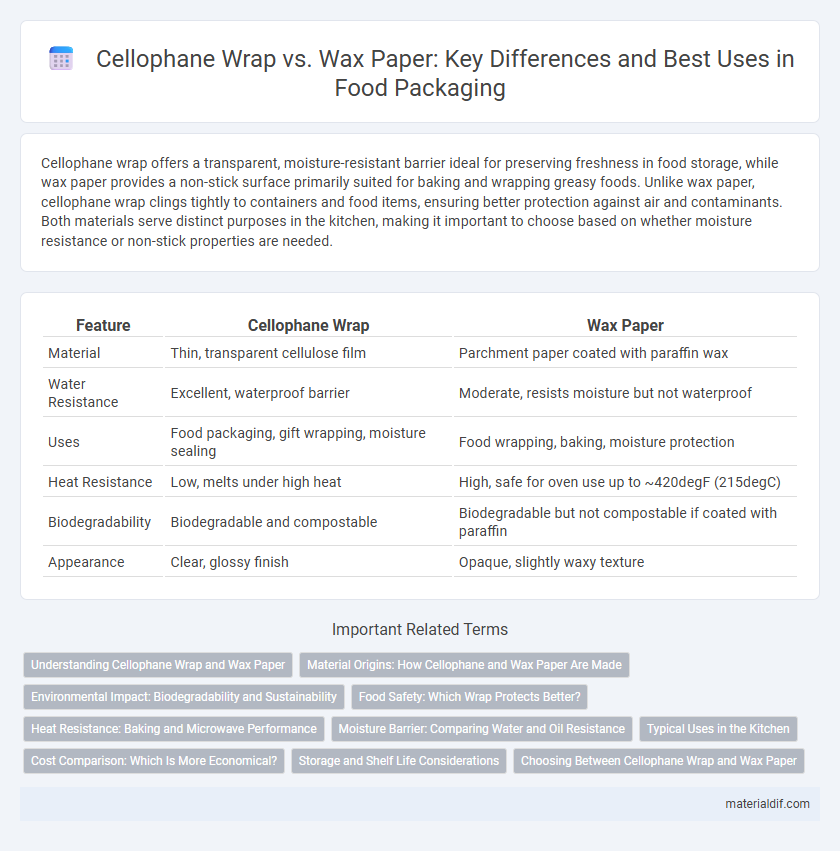Cellophane wrap offers a transparent, moisture-resistant barrier ideal for preserving freshness in food storage, while wax paper provides a non-stick surface primarily suited for baking and wrapping greasy foods. Unlike wax paper, cellophane wrap clings tightly to containers and food items, ensuring better protection against air and contaminants. Both materials serve distinct purposes in the kitchen, making it important to choose based on whether moisture resistance or non-stick properties are needed.
Table of Comparison
| Feature | Cellophane Wrap | Wax Paper |
|---|---|---|
| Material | Thin, transparent cellulose film | Parchment paper coated with paraffin wax |
| Water Resistance | Excellent, waterproof barrier | Moderate, resists moisture but not waterproof |
| Uses | Food packaging, gift wrapping, moisture sealing | Food wrapping, baking, moisture protection |
| Heat Resistance | Low, melts under high heat | High, safe for oven use up to ~420degF (215degC) |
| Biodegradability | Biodegradable and compostable | Biodegradable but not compostable if coated with paraffin |
| Appearance | Clear, glossy finish | Opaque, slightly waxy texture |
Understanding Cellophane Wrap and Wax Paper
Cellophane wrap is a transparent, thin film made from regenerated cellulose, offering moisture resistance and breathability essential for food preservation. Wax paper, coated with a thin layer of paraffin wax, provides a non-stick surface and moisture barrier but lacks the breathability of cellophane. Understanding their distinct properties helps determine their best use: cellophane wrap for sealing freshness and visibility, wax paper for wrapping and separating items without moisture exchange.
Material Origins: How Cellophane and Wax Paper Are Made
Cellophane is made from cellulose derived from wood pulp or cotton fibers, undergoing a chemical process involving alkali and carbon disulfide to form viscose, which is then regenerated into a transparent film. Wax paper originates from standard paper coated with paraffin wax or soybean wax to create a moisture-resistant surface, using paper fibers primarily sourced from wood pulp. The distinct material origins and production methods give cellophane its biodegradable, breathable qualities, while wax paper remains water-resistant but less transparent and less biodegradable.
Environmental Impact: Biodegradability and Sustainability
Cellophane wrap, derived from cellulose, is biodegradable and compostable, making it a more environmentally sustainable option compared to wax paper, which often contains polyethylene coating that hinders decomposition. Cellophane's renewable plant-based origin reduces reliance on petroleum-based plastics, aligning with eco-friendly packaging goals. Wax paper, despite its water-resistant properties, typically contributes to landfill waste due to poor biodegradability and difficulties in recycling.
Food Safety: Which Wrap Protects Better?
Cellophane wrap offers superior breathability and moisture resistance compared to wax paper, reducing the risk of food spoilage by allowing trapped gases to escape while maintaining adequate moisture levels. Wax paper is coated with paraffin, making it moisture-resistant but less effective at preventing condensation buildup, which can promote bacterial growth on perishable foods. For food safety, cellophane's natural cellulose composition ensures better protection against contamination and preserves food freshness longer than wax paper.
Heat Resistance: Baking and Microwave Performance
Cellophane wrap has limited heat resistance and is not suitable for baking or microwave use, as it can melt or release harmful chemicals under high temperatures. Wax paper withstands moderate heat and is safe for microwave use but should not be used for baking as the wax coating can melt or ignite. For cooking applications involving heat, parchment paper is a better alternative due to its superior heat resistance compared to both cellophane wrap and wax paper.
Moisture Barrier: Comparing Water and Oil Resistance
Cellophane wrap offers superior moisture barrier properties compared to wax paper, providing excellent resistance to both water and oil. Unlike wax paper, which can absorb moisture and lose effectiveness when in contact with liquids, cellophane maintains its structural integrity and prevents moisture transfer. This makes cellophane an optimal choice for preserving the freshness of food items by effectively blocking water vapor and oils.
Typical Uses in the Kitchen
Cellophane wrap is commonly used for preserving freshness in food storage, such as wrapping sandwiches, fruits, and vegetables due to its moisture-resistant and transparent qualities. Wax paper serves primarily as a non-stick surface for baking and food preparation, ideal for lining cake pans and wrapping greasy foods to prevent leakage. Both materials aid in kitchen tasks but excel in different roles: cellophane excels in sealing and visibility, while wax paper offers heat resistance and non-stick benefits.
Cost Comparison: Which Is More Economical?
Cellophane wrap typically costs more per roll than wax paper due to its biodegradable material and specialized production process. Wax paper offers a cheaper option for basic food wrapping and storage, making it more economical for everyday use. However, the durability and moisture resistance of cellophane wrap can reduce waste and provide long-term savings despite the higher initial price.
Storage and Shelf Life Considerations
Cellophane wrap offers superior breathability compared to wax paper, making it ideal for storing fresh produce by reducing moisture buildup and extending shelf life. Wax paper provides a moisture-resistant barrier, suitable for short-term storage of dry goods but less effective in preventing spoilage from humidity. For long-term storage, cellophane's biodegradable and non-toxic properties contribute to maintaining food quality without compromising safety or freshness.
Choosing Between Cellophane Wrap and Wax Paper
Cellophane wrap offers superior moisture resistance and clarity, making it ideal for packaging fresh produce and gifts that require visibility and protection from humidity. Wax paper provides a non-stick surface and excellent grease resistance, making it better suited for baking and food preparation tasks like wrapping sandwiches or lining pans. Choosing between cellophane wrap and wax paper depends on whether you need transparency and moisture barrier properties or a grease-resistant, non-stick surface for cooking purposes.
Cellophane Wrap vs Wax Paper Infographic

 materialdif.com
materialdif.com